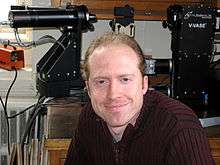Joshua Pearce
Joshua M. Pearce is an academic engineer at Michigan Tech known for his work on protocrystallinity, photovoltaic technology, open source appropriate technology, and open source hardware including RepRap 3D printers.
Dr. Pearce received his Ph.D. at The Pennsylvania State University, where his work on protocrystallinity helped develop low-cost amorphous silicon solar photovoltaic technology.[1] His solar research continues,[2][3] but he is also a vocal advocate of an open source approach to technical development.[4] Ars Technica compared him to Richard Stallman,[5] an American software freedom activist, for his work related to open-source nanotechnology.[6] He applied open-source 3-D printing and electronics to scientific equipment design, where he has claimed both superior innovation and lower costs.[7][8]
His research has shown that printing household items with a RepRap is less costly[9] and better for the environment[10] than purchasing conventionally manufactured goods. Similarly, his group developed the recyclebot, a waste plastic extruder, which drops the cost of 3D printing filament from $35/kg to ten cents per kg while making recycling even more environmentally beneficial.[11][12]
In 2013 his group released an open-source 3D printer capable of printing in steel, which cost less than US$1,200.[13][14] in order to encourage more rapid technological development according to Scientific American.[15] This cost reduction was significant as the New York Times reported commercial metal printers at the time cost over US$500,000.[16]
Following the same approach, Dr. Pearce developed the early work on open source appropriate technology, which is technology that is designed with special consideration to the environmental, ethical, cultural, social, political, and economical aspects of the community it is intended for) that are designed in the same fashion as free and open source software.[17] For example, he further developed inexpensive methods such as SODIS to disinfect drinking water in the developing world, using sunlight, water bottles, and salt.[18]
Bibliography
- Open-Source Lab (book):How to Build Your Own Hardware and Reduce Research Costs (2014)
- David Denkenberger and Joshua Pearce, Feeding Everyone No Matter What: Managing Food Security After Global Catastrophe, Academic Press (2015).
References
- ↑ "Control of Staebler-Wronski defects in hydrogenated amorphous silicon for the de". Adsabs.harvard.edu. Retrieved 2013-09-05.
- ↑ "Efficiency breakthrough in solar thermal cells - Cogeneration & On-Site Power Production". Cospp.com. Retrieved 2013-09-05.
- ↑ Herman K. Trabish (2011-12-07). "New Study: Solar Grid Parity Is Here Today". Greentech Media. Retrieved 2013-09-05.
- ↑ "Podcast Interview". Sciencemag.org. 2012-09-14. doi:10.1126/science.1228183. Retrieved 2013-09-05.
- ↑ Timmer, John (2012-11-21). "Stallman’s got company: Researcher wants nanotech patent moratorium". Ars Technica. Retrieved 2013-09-05.
- ↑ Pearce, Joshua M. (2012). "Make nanotechnology research open-source". Nature 491: 519–521. doi:10.1038/491519a.
- ↑ "3D Printing Brings the Science Lab to Your Backyard". Popular Mechanics. 2012-09-13. Retrieved 2013-09-05.
- ↑ McMurtrie, Beth (2013-03-29). "Lab Equipment Made With 3-D Printers Could Cut Costs by 97% - Percolator - The Chronicle of Higher Education". Chronicle.com. Retrieved 2013-09-05.
- ↑ Study: At-home 3-D printing could save consumers 'thousands' - CNN, 7/31/2013
- ↑ 3D printers use less energy than traditional manufacturing - Gigaom - available http://gigaom.com/2013/10/03/3d-printers-use-less-energy-than-traditional-manufacturing/ 3/10/2013.
- ↑ Michigan Tech Prof Says You Can Save Big With Milk Jug Recycling For 3D Printing - CBS 3/5/2014
- ↑ Need 3D printer filament? Got milk? - Ars Technica
- ↑ Loose screw? 3-D printer may soon forge you a new one - NBC News
- ↑ Testing your metal- Newsweek
- ↑ http://www.scientificamerican.com/article/new-3d-metal-printer-open-source-affordable/
- ↑ An Inexpensive Way to Print Out Metal Parts - The New York Times, 2013/12/10/
- ↑ Joshua M. Pearce, The Case for Open Source Appropriate Technology, Environment, Development and Sustainability, 14, pp. 425-431 (2012)
- ↑ Cuda, Gretchen (2012-05-08). "Recipe For Safer Drinking Water? Add Sun, Salt And Lime : The Salt". NPR. Retrieved 2013-09-05.
